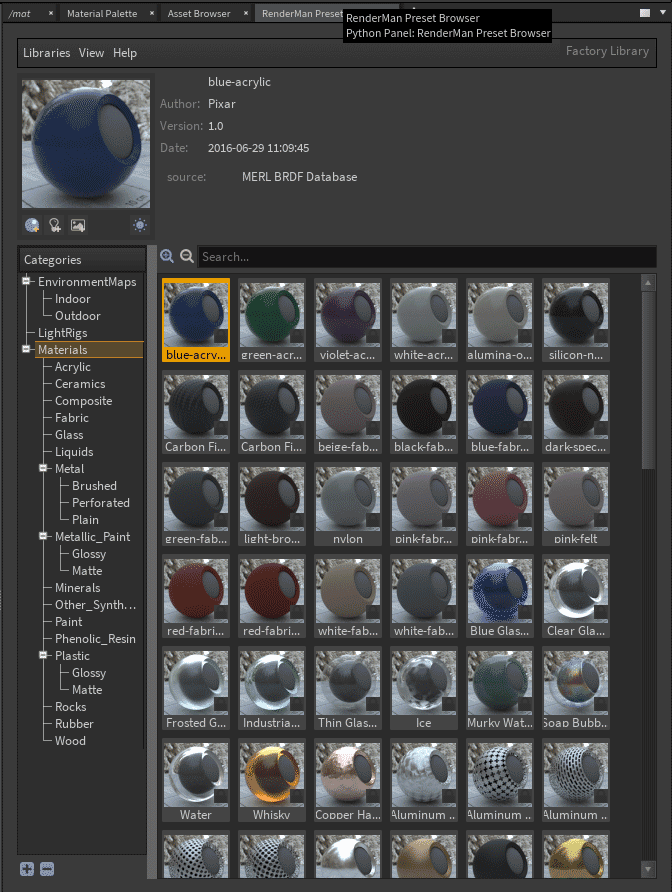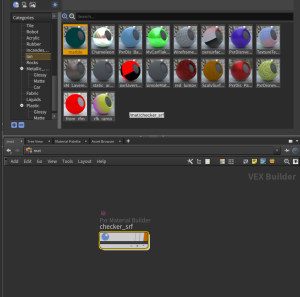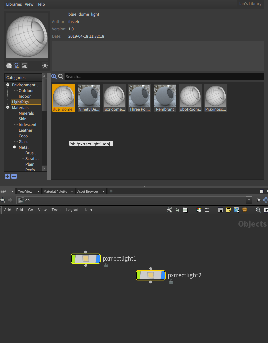Contents
You can open the Preset Browser by adding a tab/panel in Houdini > New Pane Tab Type > RenderMan Preset Browser
Presets include categories for light rigs, environment lights, and materials.
- You can search for assets by name, usage category, or metadata.
- You can choose two sizes of preset images.
Materials
Saving/Exporting a material is easy!
- Select the PxrMaterialBuilder Node (the export will recognize connected nodes) Be sure there's a (single) BxDF inside the Material Builder or we don't know what to save/render.
- Choose the category you want from the Preset Browser
- Choose the Save icon (the material ball+ icon underneath the preview image)
For convenience, you can also drag and drop the PxrMaterialBuilder to save the asset. Select the node, click and hold the left mouse button, drag the node onto the Preset Browser tab, and let go of the mouse button.
- Give it a useful name and any desired metadata for your pipeline
- RenderMan will generate a preview swatch render, this will auto-populate in the Preset Browser
- Importing/Using a saved asset
- Simply right-click and choose "Import and Assign" to a selected object
- Make any adjustments for your object as needed!
Light Rigs
- Saving/Exporting a light rig is as easy as materials!
- Make sure that the LighRigs category is selected.
- Select the light nodes that you want to go into the light rig asset.
- Click the Save icon (the light bulb icon underneath the preview image)
Give it a useful name and any desired metadata for your pipeline
The same as materials, you can also drag and drop your light nodes onto the Preset Browser tab to create light rigs.
Importing/Using a saved light rig
- Simply right-click and choose "Import" to import the light rig into your scene
- The Preset Browser will import all the lights in the light rig under one subnet node.
Environment Maps
- You can save an Environment Map using the image icon+ underneath the large preview swatch in the Preset Browser
- Select the Environment category in the Preset Browser
- Choose the desired OpenEXR or .HDR file from the file browser window
- You can add/change metadata in the dialog or change the name.
- Then we convert the image to a compatible .tex format. This may take time depending on the original image size.
- A preview render is then performed and automatically populated in the browser category.
- Using a saved map is easy.
- Select a PxrDomeLight object node.
- Right-click the asset and import.
Changing the map is as easy as double-clicking another environment map asset!
If a PxrDomeLight object node is not selected when importing a map, the Preset Browser will automatically create one for you.
Asset Dependencies
When an asset is saved to disk, all its dependencies are saved to disk too.
These include :
- Textures : stored in tex format, UDIM is supported.
- HDRI environment maps : stored in tex format. We use a specific combination of flags to compress the texture as efficiently as possible.
- OSL shaders : stored in oso format to protect your IP, but you can manually add the osl file in the asset directory if you want to share the source code.
These dependencies can increase the size of a preset on disk and you should bear that in mind if you want to distribute them over the internet.
Cross-Application Materials
RenderManAssets have been designed to be easily transferable from one application (like Houdini) to another (Katana, Maya, Blender, etc) and vice-versa.
Compatibility Issues
Still, it is possible to run into compatibility issues if your material contains native Houdini nodes. To mitigate these problems, each RenderManAsset maintains a list of used nodes and use it to evaluate the preset's compatibility with the current host application and display a warning if it is not compatible.
The system will check :
- if the asset contains host-specific nodes
- if the asset's renderer version is superior or equal to the current version
- if the asset contains host-specific nodes, make sure the current host version is superior or equal to the asset's host version.
Best Practice
If you want to ensure cross-application compatibility, avoid non-Pixar BxDFs and Patterns.
Library Configuration
RenderMan ships with a standard library that can be found in : $RMANTREE/lib/RenderManAssetLibrary
We recommend that you copy the standard library to a location of your choice and leave the default library untouched as a backup. The new copy should be readable and writable. The asset browser will not allow you to create new assets if it points to a non-writable location.
Environment variable
The location of the asset library can be set through the RMAN_ASSET_LIBRARY environment variable.



